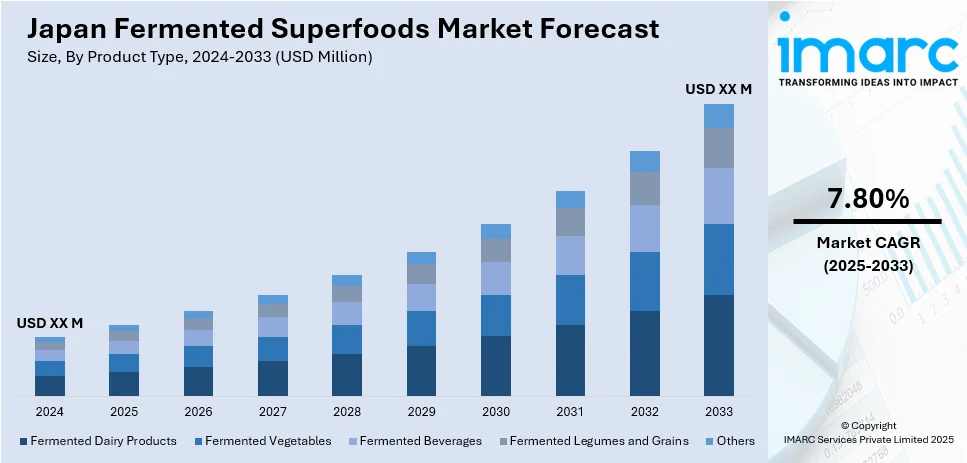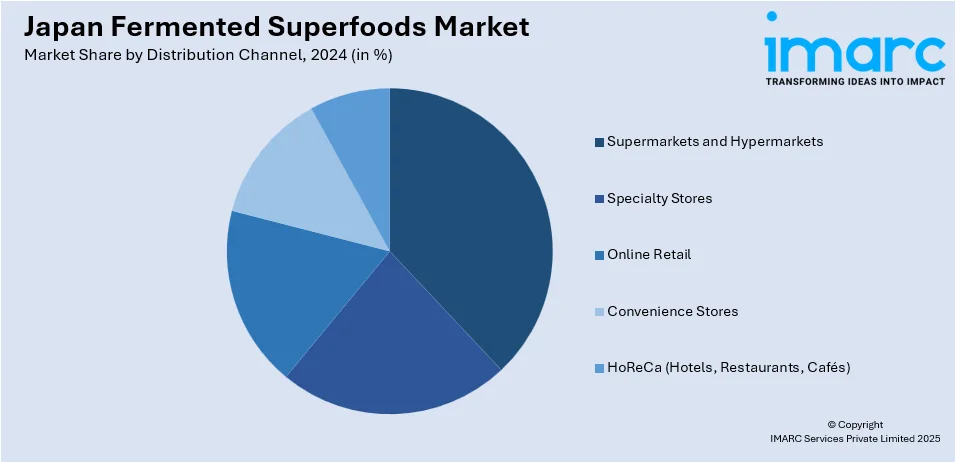
Japan Fermented Superfoods Market Size, Share, Trends and Forecast by Product Type, Distribution Channel, End User, and Region, 2025-2033
Japan Fermented Superfoods Market Overview:
The Japan fermented superfoods market is projected to exhibit a growth rate (CAGR) of 7.80% during 2025-2033. The market is experiencing significant growth, driven by increased health consciousness and a strong cultural affinity for fermented foods. Traditional staples like miso, natto, and koji are also being reimagined into modern formats such as probiotic drinks and plant-based alternatives. This evolution caters to the aging population's demand for digestive health and immune support. Innovations in fermentation technology and the popularity of functional foods are further propelling the market, enhancing the Japan fermented superfoods market share.
|
Report Attribute
|
Key Statistics
|
|---|---|
|
Base Year
|
2024
|
|
Forecast Years
|
2025-2033
|
|
Historical Years
|
2019-2024
|
| Market Growth Rate 2025-2033 | 7.80% |
Japan Fermented Superfoods Market Trends:
Rising Health and Wellness Focus
As Japanese consumers become more health-aware, they are focusing more on digestive health and overall well-being, and so fermented superfoods are on a roll. Foods that are high in probiotics, including kimchi, miso, and kefir, are now becoming staples in daily diets because of their capability to improve gut health and immune function. For instance, in January 2025, Hikari Miso Co., Ltd. expanded its “THE ORGANIC” series with two new products: “THE ORGANIC MISO GENMAI” and “THE ORGANIC MISO MUGIKOJI”. Made from premium organic ingredients, these eco-friendly misos offer unique flavors in sustainable packaging, catering to health-conscious consumers and promoting environmental responsibility. Consumers are now on the lookout for functional foods that provide nutritional value and help overall well-being. Fermented superfoods, rich in probiotics, are considered potent natural remedies for a healthy microbiome and digestive system. This growing consciousness of gut wellness is part of Japan's overall wellness trend, where interest in holistic, preventive health dictates food selection. Consequently, demand for fermented superfoods keeps increasing, and consumers are looking for foods that are tasty as well as nutritious to include in their diet.

Existing Aging Population
Japan's aging population is significantly contributing to the growth of the fermented superfoods market, as older adults seek foods that support their health and well-being. According to industry reports, Japan’s elderly population reached a record 36.25 million, making up nearly 30% of the total population. With women accounting for 20.53 million. Fermented superfoods are gaining popularity due to their potential to aid digestion, improve gut health, and strengthen immunity, which are essential for aging individuals. Products like miso, natto, and kimchi are rich in probiotics and enzymes that help maintain digestive balance, reduce inflammation, and enhance nutrient absorption critical factors for seniors. With Japan’s elderly population seeking ways to stay healthier longer, functional foods such as fermented superfoods are seen as a convenient and effective solution. This trend is fueling the market, as more consumers prioritize foods that offer both health benefits and convenience. As a result, Japan fermented superfoods market growth is experiencing strong momentum, driven by the needs of its aging demographic.
Japan Fermented Superfoods Market Segmentation:
IMARC Group provides an analysis of the key trends in each segment of the market, along with forecasts at the country and regional levels for 2025-2033. Our report has categorized the market based on product type, distribution channel, and end user.
Product Type Insights:
- Fermented Dairy Products
- Yogurt
- Kefir
- Buttermilk
- Fermented Vegetables
- Kimchi
- Sauerkraut
- Pickles
- Fermented Beverages
- Kombucha
- Kanji
- Fermented Teas
- Fermented Legumes and Grains
- Idli
- Dosa
- Dhokla
- Tempeh
- Miso
- Others
The report has provided a detailed breakup and analysis of the market based on the product type. This includes fermented dairy products (yogurt, kefir, and buttermilk), fermented vegetables (kimchi, sauerkraut, and pickles), fermented beverages (kombucha, kanji, and fermented teas), fermented legumes and grains (idli, dosa, dhokla, tempeh, and miso), and others.
Distribution Channel Insights:

- Supermarkets and Hypermarkets
- Specialty Stores
- Online Retail
- Convenience Stores
- HoReCa (Hotels, Restaurants, Cafés)
A detailed breakup and analysis of the market based on the distribution channel have also been provided in the report. This includes supermarkets and hypermarkets, specialty stores, online retail, convenience stores, and HoReCa (hotels, restaurants, cafés).
End User Insights:
- Households
- Food Service Industry
- Health and Wellness Industry
A detailed breakup and analysis of the market based on the end user have also been provided in the report. This includes households, food service industry, and health and wellness industry.
Regional Insights:
- Kanto Region
- Kansai/Kinki Region
- Central/Chubu Region
- Kyushu-Okinawa Region
- Tohoku Region
- Chugoku Region
- Hokkaido Region
- Shikoku Region
The report has also provided a comprehensive analysis of all the major regional markets, which include Kanto Region, Kansai/Kinki Region, Central/Chubu Region, Kyushu-Okinawa Region, Tohoku Region, Chugoku Region, Hokkaido Region, and Shikoku Region.
Competitive Landscape:
The market research report has also provided a comprehensive analysis of the competitive landscape. Competitive analysis such as market structure, key player positioning, top winning strategies, competitive dashboard, and company evaluation quadrant has been covered in the report. Also, detailed profiles of all major companies have been provided.
Japan Fermented Superfoods Market News:
- In August 2024, Takano Foods and Kirin Holdings launched "Sugoi Natto Gold with Plasma Lactobacillus Sauce," which aims to increase immunity through regular natto consumption. Each pack contains 50 billion beneficial bacteria.
- In March 2023, the Japan natto cooperative society federation launched its English website, “Natto Power,” on March 6 to promote natto, a traditional Japanese fermented food. The site highlights natto's health benefits and unique characteristics, aiming to increase global interest in this nutrient-rich food, which is made from soybeans and bacillus natto.
Japan Fermented Superfoods Market Report Coverage:
| Report Features | Details |
|---|---|
| Base Year of the Analysis | 2024 |
| Historical Period | 2019-2024 |
| Forecast Period | 2025-2033 |
| Units | Million USD |
| Scope of the Report |
Exploration of Historical Trends and Market Outlook, Industry Catalysts and Challenges, Segment-Wise Historical and Future Market Assessment:
|
| Product Types Covered |
|
| Distribution Channels Covered | Supermarkets and Hypermarkets, Specialty Stores, Online Retail, Convenience Stores, HoReCa (Hotels, Restaurants, Cafés) |
| End Users Covered | Households, Food Service Industry, Health and Wellness Industry |
| Regions Covered | Kanto Region, Kansai/Kinki Region, Central/Chubu Region, Kyushu-Okinawa Region, Tohoku Region, Chugoku Region, Hokkaido Region, Shikoku Region |
| Customization Scope | 10% Free Customization |
| Post-Sale Analyst Support | 10-12 Weeks |
| Delivery Format | PDF and Excel through Email (We can also provide the editable version of the report in PPT/Word format on special request) |
Key Questions Answered in This Report:
- How has the Japan fermented superfoods market performed so far and how will it perform in the coming years?
- What is the breakup of the Japan fermented superfoods market on the basis of product type?
- What is the breakup of the Japan fermented superfoods market on the basis of distribution channel?
- What is the breakup of the Japan fermented superfoods market on the basis of end user?
- What is the breakup of the Japan fermented superfoods market on the basis of region?
- What are the various stages in the value chain of the Japan fermented superfoods market?
- What are the key driving factors and challenges in the Japan fermented superfoods market?
- What is the structure of the Japan fermented superfoods market and who are the key players?
- What is the degree of competition in the Japan fermented superfoods market?
Key Benefits for Stakeholders:
- IMARC’s industry report offers a comprehensive quantitative analysis of various market segments, historical and current market trends, market forecasts, and dynamics of the Japan fermented superfoods market from 2019-2033.
- The research report provides the latest information on the market drivers, challenges, and opportunities in the Japan fermented superfoods market.
- Porter's five forces analysis assist stakeholders in assessing the impact of new entrants, competitive rivalry, supplier power, buyer power, and the threat of substitution. It helps stakeholders to analyze the level of competition within the Japan fermented superfoods industry and its attractiveness.
- Competitive landscape allows stakeholders to understand their competitive environment and provides an insight into the current positions of key players in the market.
Need more help?
- Speak to our experienced analysts for insights on the current market scenarios.
- Include additional segments and countries to customize the report as per your requirement.
- Gain an unparalleled competitive advantage in your domain by understanding how to utilize the report and positively impacting your operations and revenue.
- For further assistance, please connect with our analysts.
 Request Customization
Request Customization
 Speak to an Analyst
Speak to an Analyst
 Request Brochure
Request Brochure
 Inquire Before Buying
Inquire Before Buying




.webp)




.webp)












